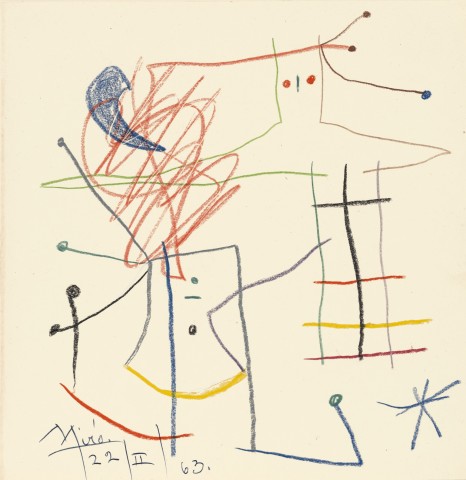SANS TITRE, 1963
JOAN MIRÓ
wax crayon on paper
25.0 x 24.5 cm
signed and dated lower left: Mirò / 22 /II/63
accompanied by a certificate of authenticity from the Association pour la Défense de l'œuvre de Joan Miró (ADOM), signed and dated by Ariane Mainaud, 2 October 2013
Private collection
Artcurial, Paris, 27 March 2013, lot 144
Nicholas Gallery, Belfast, Ireland (label attached verso)
Private collection, Melbourne, acquired from the above
By the 1960s Catalan artist Joan Mirò was a titan of Modern Art, his idiosyncratic works combining abstract formalism with surrealist whimsy having been exhibited to great acclaim in major retrospective exhibitions both New York and Paris. Despite having spent most of his time between Montroig on the north-eastern coast of Spain and Paris, where he worked alongside his peers from the Ecole de Paris, in 1956 Mirò settled on the island of Mallorca, in a purpose-built studio designed by Josep Lluís Sert, a prestigious architect and friend of the artist. Mirò’s final years on the island were the most prolific of his artistic career, prompted by a period of contemplation of the past and renewal and reinvention of his early symbolic vocabulary. The works produced from this period were boldly experimental, and emphatic in their gesture. Sans Titre, 1963 is a small work on paper, an intimate, spontaneous composition drawn quickly in the space of a single day, as indicated by the date inscribed lower left, 22nd February 1963.
Prioritising a flat and compressed pictorial plane, Mirò’s art was radical and decidedly modern. With authoritative bold lines in unmodulated colours placed on a uniform white sheet of paper, Mirò creates a grid of interlocking symbols. These totems of Mirò’s artistic language are suspended together like a constellation. Avant-garde in their reductive expression, these glyphs are intended to be suggestive rather than literal, working in the realm of surrealist and Dadaist free association. Like his peers in the Ecole de Paris, Mirò was influenced by contemporary psychology and reappraisal of children’s art. They found the purest form of artistic expression in automatic, spontaneous drawing, unhindered by conscious censorship or imposed formal logic.
Thus reduced to poetic essentials, Mirò’s vocabulary is universally accessible and whimsically humorous. Sans Titre features many of the artist’s most recognisable motifs, featuring in his works since the late 1930s: an asterisk-like star, a crescent moon, Twombly-esque concentric spirals, a cross hatched ladder and two figures evoked with a pseudo morse code for the eyes and nose, dot-dash-dot. The sparse matrix of symbols is endowed with a personal and autobiographical power known only to the artist, but whose joyful poetic quality can be keenly felt by all.
LUCIE REEVES-SMITH
